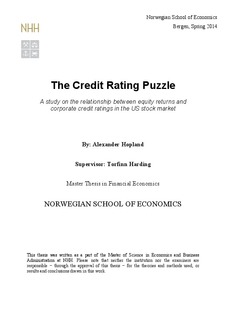The credit rating puzzle : a study on the relationship between equity returns and corporate credit ratings in the US stock market
Master thesis
Permanent lenke
http://hdl.handle.net/11250/224259Utgivelsesdato
2014Metadata
Vis full innførselSamlinger
- Master Thesis [4372]
Sammendrag
This study search to investigate the relationship between credit risk, measured by S&P longterm
domestic issuer credit rating, and stock returns. Analyzing 3,172 companies over the
period January 1985 to December 2013 we investigate if it exist a relationship using several
methods. In the first part we generate portfolios sorted by credit rating, and analyze how
certain firm characteristics and returns varies between good and bad rated stocks. Secondly,
we are running panel data regressions on individual securities controlling for several control
variables, such as book-to-market, market value of equity, and share turnover. We find a
negative relationship between stock returns and credit ratings, suggesting that worst rated
stocks on average yield lower returns than better-rated stocks. Market value of equity
decrease monotonously as rating deteriorates. However, we also find that the credit rating
effect is related to worst rated stocks. Excluding the worse rated stocks, we find no statistical
evidence that there exist a negative effect, until we include BB- rated stocks. In times of
recession the effect is stronger than in expansions, suggesting that credit ratings may be of
more interest for investors when there exist a higher risk of financial distress. Around
downgrades (upgrades) returns have a downward (upward) trend ex-ante the event. After
change in credit quality, we notice returns bounce back on a level equal securities that did not
experience any rating action. It is no clear explanation to this negative relationship. Existing
literature suggest that majority shareholders can extract private benefits from distressed
companies, buying the companies assets or output at lower price. Hence, the observed return
is lower than the realized return. For smaller companies with low analyst coverage, bad news
travel more slowly than in large firms with higher analyst coverage, and the
underperformance can be explained due to investor’s underreaction to negative information.
